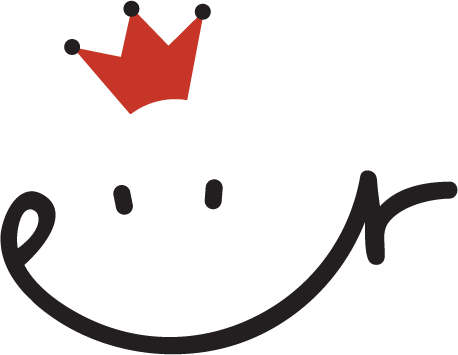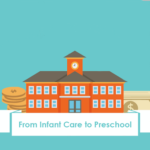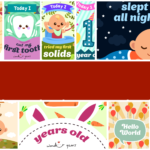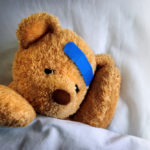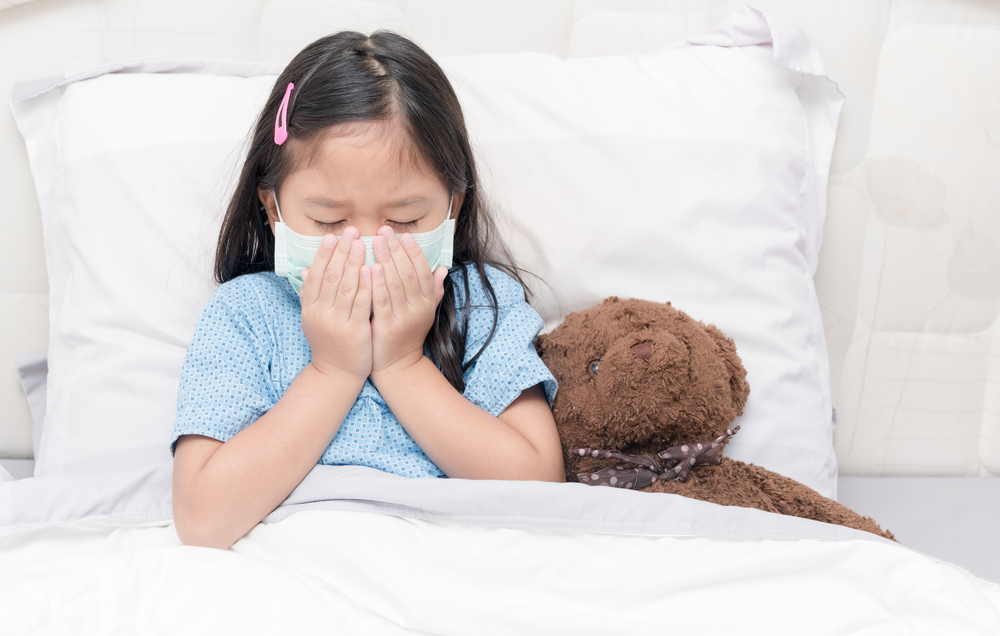
Falling sick is a normal part of childhood. In fact, the good news is, children who recover from some childhood illnesses earlier in life obtain immunity ahead of others as well.
Most common childhood illnesses
As a parent or caregiver to little ones, we can be prepared for childhood illnesses and take better care of our kid’s health by understanding their symptoms and treatment.
Here’s a list for your information.
1. Sore Throat
Sore throats are painful for children and can be caused by a virus or bacteria. Babies and toddlers rarely get a sore throat from bacteria infection, but they might get infected if they are in childcare, if they have an older sibling that has been infected or if they play with a toy or object that has the bacteria.
Symptoms
- Pain in throat
- Dryness in throat
- Loss of voice
Treatment
- Plenty of fluids
- Ample rest
- Small but nutritious meals
- Sore throats caused by the virus do not need antibiotics
- If your child has been infected by bacteria (also known as Strep), age-appropriate antibiotics may be prescribed by the doctor, in which case, it is necessary to complete the whole course.
2. Cough
Coughing is one way in which your children’s body tries to expel an irritant, such as mucus or some foreign object.
Symptoms
- Shortness of breath
- Wheezing
- Sore throat
- Headache
- Fatigue
Treatment
In some ways, coughing is more a symptom. There is no direct cure for coughing but here are some ways to soothe a coughing kid, depending on their age.
- Lozenges, cough drops or hard candy, some containing Menthol. Menthol and some herbal cough drops can help to numb your kid’s throat. Younger children may not take to menthol or herbal drops and in this case, candy may help increase saliva production, which in turn, can lubricate the throat to soothe it.
- Increased fluid consumption, with the exception of alcohol or caffeinated drinks that can dry out the throat, can help to keep your kid’s throat moist to make it more comfortable. Breastfeeding can help if your child is very young.
- Cough suppressants help to calm a cough down for sleep and Expectorants help your older kids cough up mucus, which might be causing the cough. Hence, consult your doctor to obtain the correct cough medicine for your purpose. Take note though that cough medicine is usually not recommended for children younger than 4 years old as studies have shown that they do not work for this age group and could cause serious side effects. Those with narcotics such as codeine should also not be used for children.
3. Common Cold
The symptoms of many childhood illnesses include symptoms that are like the common cold. You may want to treat the common cold as a symptom or an indication that something is awry with your child’s body.
If your child has a fever together with common cold symptoms, it is likely to be a bacterial infection.
Symptoms
- Runny and/or blocked nose
- Sneezing
- Fatigue
- Cough
- Headache
- Loss of appetite
Treatment
- Plenty of fluids
- Ample rest
- Small but nutritious meals
- Humidify your child’s environment
- Saline nasal spray / Suction bulb to relieve blocked nose
Read also: 7 Types of Headaches and How to Treat Them
4. Bronchitis and Bronchiolitis
According to Centers for Disease Control and Prevention, Bronchitis, sometimes also known as a chest cold, is an infection of the larger, more central airways in the lungs.
Bronchiolitis, on the other hand, is an infection of the small airways of the lungs.
A virus almost always causes Bronchitis and Bronchiolitis, although Bronchitis can sometimes be caused by bacteria.
Symptoms
- Coughing with or without mucus. Mucus can sometimes be bloody.
- Shortness of breath or trouble breathing
- Aching in the chest
- Fatigue
- Headaches
- Body aches
- Sore throat
- Audible wheezing sounds
- Laboured or very fast breathing
Treatment
- Ample rest
- Plenty of fluids
- Small but nutritious meals
- Humidify your child’s environment
- Saline nasal spray / Suction bulb to relieve blocked nose
- Age-appropriate medications prescribed by your doctor.
5. Croup
According to KidsClinic, Croup is a viral infection of the larynx (voice box), trachea and bronchi (windpipe) which usually lasts 3 to 7 days.
Children younger than 3 years old usually experience worse symptoms.
Symptoms
- Hoarseness of voice
- Barking cough
- High pitched squeaking sound during breathing known as stridor
- Wheezing or the sound of phlegm
- Cold symptoms such as fever or runny nose
Treatment
- Warm moist air
- Plenty of fluids
- Ample rest
- Small but nutritious meals
- Doctor-prescribed, age-appropriate medicine, which may include an anti-inflammatory steroid taken either orally or nebulized to reduce the swelling or inhalation treatment with nebulised adrenaline and oxygen.
6. Hand, Foot, Mouth Disease (HFMD)
According to HealthHub, HFMD is caused by a family of common viruses known as enteroviruses. It usually lasts for about a week but in serious cases, the brain, lungs or heart may be infected and these complications could result in fatality.
Symptoms
- Fever
- Sore throat
- Poor appetite
- Ulcers on the throat, tongue and in the mouth
- Lethargy
- Rashes on hands, feet, mouth or bum
Treatment
- Plenty of fluids
- Ample rest
- Small but nutritious meals
- Sweetened iced drinks or popsicles may help ease the pain caused by mouth ulcers
- Doctor-prescribed, age-appropriate painkillers such as paracetamol, ibuprofen, etoricoxib or celecoxib
7. Urinary Tract Infection (UTI)
According to SingHealth, UTI is an infection of the urinary tract due to the presence of bacteria in significant numbers.
This infection is common in childhood and during infancy, boys are more likely to develop them and after infancy, UTI is more common in girls because of their short urethras.
In rare situations, bacteria may enter the bloodstream from the kidneys and cause infection of the bloodstream (sepsis) or of other organs.
Symptoms
- Newborns and infants may have no symptoms other than a fever
- Older children have pain or burning during urination and/or pain in the bladder area
- Need to urinate frequently, which can cause bedwetting
- Hot and foul-smelling urine
- Blood in urine or milky/cloudy urine
- Fever
- Lower abdomen pain
- Nausea or vomiting
- Back pain, in the situation of kidney infection
Treatment
- UTI must be treated with age-appropriate antibiotics. For some children who experience vomiting or are unable to tolerate oral antibiotics, and especially very young babies under 3 months old, admission to hospital may be necessary for antibiotics injection.
- Repeated urine tests to check if the infection is gone
- Plenty of fluids
8. Kawasaki Disease
According to the National University Hospital, Kawasaki Disease is probably triggered by a virus infection that causes inflammation of the arteries, which can cause damage to the coronary arteries and affect the heart muscle.
This disease typically affects children under 5 years old, but if diagnosed early, children with this disease can possibly recover fully within a few days. Serious complications involving the heart can arise if untreated or undetected.
Symptoms
1st phase
Fever for 5 or more days; and at least 4 of the following symptoms:
- Redness in both eyes
- Rash on the back, belly, arms, legs and genital area
- Dry, red, cracked lips
- Strawberry tongue (white coating with red bumps on the tongue)
- Sore throat
- Swollen palms and soles with a purple-red color
- Swollen lymph glands
2nd phase (usually 2 weeks after the fever started)
- Peeling skin on hands and feet
- Joint pain
- Diarrhea
- Vomiting
- Belly pain
Treatment
- Intravenous (IV) dose of immune globulin (IVIG) to help fight infections. IVIG treatment also lowers the risk of coronary artery aneurysms. IVIG is given once.
- High-dose aspirin given by mouth to treat inflammation. Patients take aspirin until blood tests show that the inflammation has improved. It’s very important for children on high-dose aspirin to get the annual flu vaccine to help prevent this viral illness. That’s because there’s a small risk of a rare condition called Reye’s syndrome in children who take aspirin during a viral illness.
- In some children, IVIG may not work and doctors give steroids instead to help prevent coronary aneurysms.
Read also: 9 Things Parents Should Know About TCM for Kids
Caring for your kid’s health
While it may seem like there are many childhood illnesses that could threaten your kid’s health, there are some precautions you can take to reduce the risk and keep your child safe.
These include:
- Washing hands properly and as needed, such as after sharing toys and especially before touching their eyes, nose or mouth
- Do not allow children to share towels, pillows, washcloths or other personal items.
- Do not allow children to share food, drinks or eating and drinking utensils
- Teach children not to put fingers in their mouth
- Keep children a healthy distance away from people who are sick
- Recognise symptoms of childhood illnesses and obtain medical attention as necessary
Every parent or caregiver wants the best for their kid’s health. Now that you are equipped with information about these common childhood illnesses, you will be able to handle health situations better as they arise.
Stay healthy and well all-year-round!

